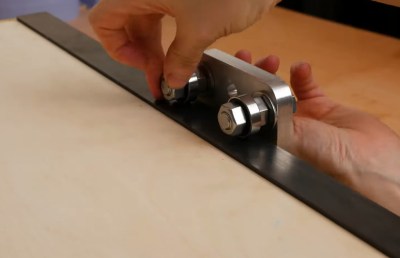Back in the day when most people read the news on wood pulp, newspaper outfits would run off a test print on a small proofing press. This gave them a chance to check for typos before printing off thousands of newspapers on the real press.
These presses can be used for more than letterpress proofing, as [Paul] proves with this DIY version (YouTube, embedded below). They are simple machines that use a heavy roller on bearings to provide uniform pressure, so they’ll work for lino-cut printmaking and aquatint etchings, too.
 The roller is the most important bit and is easily the most expensive part of a build like this one. [Paul]’s was fashioned by a UK machinist that he found through ebay. The total cost was £220 (~$300 USD), which is well below the thousand-pound mark where commercial machine prices start.
The roller is the most important bit and is easily the most expensive part of a build like this one. [Paul]’s was fashioned by a UK machinist that he found through ebay. The total cost was £220 (~$300 USD), which is well below the thousand-pound mark where commercial machine prices start.
[Paul] made the base and handle out of plywood and CNC’d the side panels out of aluminium. These side panels contain bearings that hold the roller’s ends in place. As the roller moves back and forth, it slides along on another set of bearings the underside of the press. These bearings ride thin metal rails on the underside of the press so they don’t wear grooves into the wood over time.
[Paul]’s press looks fantastic and looks like it does a great job with everything he throws at it. Some uses require raising up the surface to be printed on to get a good transfer, so [Paul] might make it adjustable in the z-direction at some point in the future. Check out the build and walk-through video after the break.
If [Paul] looks familiar, it’s because we featured his equally impressive large-format book press last spring.
Continue reading “Proofing Press Proves DIY Is A-OK” →














